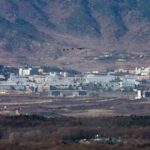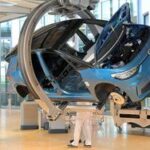
North Korea has recently announced the successful launch of a new solid-fuel intermediate-range ballistic missile (IRBM). Still, South Korea’s military has raised doubts over the claims, suggesting the possibility of deception.
While the launch of the solid-fuel missile has been confirmed, skepticism remains regarding North Korea’s reported advancements in hypersonic missile technology.
During a regular briefing on Tuesday, Lee Sung Jun, the spokesperson for South Korea’s Joint Chiefs of Staff (JCS), noted that North Korea had conducted a performance test of a new solid-fuel hypersonic missile last April. He further stated, “We view this missile as an extension of that development,” indicating that the recent launch is likely an upgraded version of North Korea’s earlier models.
North Korea has been steadily developing hypersonic and solid-fuel missiles. However, it wasn’t until January of last year that they first combined these technologies in an IRBM. Three months later, North Korea unveiled the Hwasong-16B, an IRBM equipped with a hypersonic glide vehicle, which represented a significant design shift away from the previous conical warhead design.
While no specific name has been assigned to the missile launched recently, many experts suspect it is an improved version of the Hwasong-16B, first tested in April 2024.
A report from North Korea’s state-run media, KCNA (Korean Central News Agency), announced that the Missile Industry Department successfully conducted a test launch of the new hypersonic IRBM. The report further claimed that new carbon fiber composite materials were used in the propulsion system. A comprehensive method based on accumulated technologies was applied to the missile’s flight and guidance control systems.
There is growing speculation that North Korea has abandoned its self-reliance policy and is receiving advanced materials from Russia, including carbon fiber and hypersonic technologies.
While South Korean military officials have refrained from making definitive statements, they have acknowledged the possibility. “It is difficult to comment definitively on the possibility of technological cooperation with Russia,” a South Korean spokesperson said. However, we recognize that such cooperation may exist.”
Military Concerns: Potential Deception in North Korea’s Claims on Flight Range and Altitude
South Korean military authorities doubt the authenticity of North Korea’s claims about the missile’s performance. Specifically, they question the missile’s reported flight range and apex altitude.
“We believe there is a high possibility of deception regarding North Korea’s claims on the missile’s flight range and secondary apex altitude,” the spokesperson said. According to analyses by South Korea, the U.S., and Japan, the missile’s range is approximately 1,100 kilometers (approximately 684 miles), and there was no secondary apex altitude as claimed by North Korea.
Earlier, North Korea’s state media reported that the missile reached a speed of Mach 12 (12 times the speed of sound), achieving a first apex altitude of 99.8 kilometers (about 62 miles) and a secondary altitude of 42.5 kilometers (around 26.4 miles). The report also claimed that the missile hit a virtual target area 1,500 kilometers away in international waters.
Military experts have long noted North Korea’s propaganda, agitation, and deception expertise. The spokesperson emphasized, “North Korea is fundamentally an organization skilled in these areas. Given that it maintains a dedicated propaganda department, the regime engages in exaggerations and misleading announcements.”
He continued, “The specifics of this hypersonic missile will need to be confirmed through careful analysis by South Korea and the U.S.”
While it is confirmed that the missile used a solid-fuel engine, the hypersonic technology remains unverified. Japan’s Chief Cabinet Secretary, Yoshimasa Hayashi, also expressed skepticism, stating, “We believe the missile launched yesterday was a solid-fuel IRBM, but we are still analyzing the details, including whether it was truly a hypersonic weapon.”
Military authorities are monitoring for any signs of further North Korean provocations. “We assess that there is a possibility of further provocations,” the spokesperson said, adding that they monitor various military activities, including missile launch movements.
Recent reports suggest that South Korean and U.S. forces have detected the movement of various-sized transporter erector launchers (TELs) equipped with missiles around the Pyongyang area, raising concerns that additional missile tests may be imminent.















Most Commented